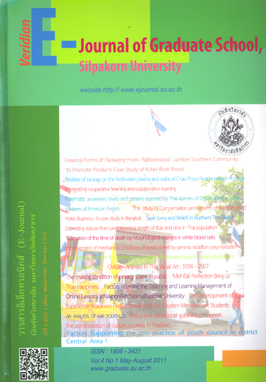การกลายพันธุ์ของไมโครแซทเท็ลไลท์ในการถ่ายทอดทางฝ่ายพ่อที่ตำแหน่ง CSF1PO : กรณีศึกษาจำนวน 3 กรณีที่อัลลีลของพ่อไม่ตรงกับลูก
Main Article Content
บทคัดย่อ
บทคัดย่อ
ในปัจจุบัน การตรวจพิสูจน์ความสัมพันธ์ พ่อ แม่และลูก เป็นที่รู้จักกันอย่างแพร่หลาย เนื่องจาก สามารถนำผลที่ได้นั้นมาใช้ในการตรวจสอบทางกฎหมาย ซึ่งในประเทศไทยได้ทำการตรวจโดยใช้ STR 16 ตำแหน่ง ซึ่งจากการสำรวจที่สถาบันนิติเวชวิทยา โรงพยาบาลตำรวจ สำนักงานตำรวจแห่งชาติ พบว่า การ วิเคราะห์โดยใช้น้ำยา AmpFℓSTR ® Identifiler kits มีกรณีศึกษาจำนวน 3 ครอบครัวที่ให้ผลขัดแย้งกัน คือ อัลลีลของลูกไม่เข้ากันกับผู้ที่สงสัยว่าเป็นพ่อ 1 ตำแหน่ง คือ ตำแหน่ง CSF1PO จึงได้มีการตรวจ เพิ่มเติมโดยใช้น้ำยาAmpFℓSTR® Y-filer™ kits นอกจากนี้ได้ทำการวิเคราะห์การเรียงตัวของลำดับเบสใน ตำแหน่ง CSF1PO เพื่อดูการเปลี่ยนแปลงของลำดับเบสในกรณีที่เกิดการกลายพันธุ์ (Mutation) เกิดขึ้น
ผลการศึกษา พบว่า กรณีศึกษาที่ 1 ผลการตรวจ STR 16 ตำแหน่ง โดยใช้น้ำยา AmpFℓSTR® Identifiler kits ที่ตำแหน่ง CSF1PO มีอัลลีล ดังนี้ พ่อ 11/12, แม่ 10/12, ลูก 12/13 และได้มีการตรวจ เพิ่มเติมโดยใช้น้ำยา AmpFℓSTR® Y-filer™ kits พบว่า เข้ากันได้อย่างสมบูรณ์ กรณีศึกษาที่ 2 ผลการ ตรวจ STR 16 ตำแหน่ง โดยใช้น้ำยา AmpFℓSTR ® Identifiler kits ที่ตำแหน่ง CSF1PO มีอัลลีล ดังนี้ พ่อ 10/12, แม่ 10/10, ลูก 10/11 และได้มีการตรวจเพิ่มเติมโดยใช้น้ำยา AmpFℓSTR® Y-filer™ kits พบว่า เข้ากันได้อย่างสมบูรณ์ กรณีที่ศึกษาที่ 3 ผลการตรวจ STR 16 ตำแหน่ง โดยใช้น้ำยา AmpFℓSTR® Identifiler kits ที่ตำแหน่ง CSF1PO มีอัลลีล ดังนี้ พ่อ 11/13, แม่ 11/11, ลูก 11/12 และได้มีการตรวจ ยืนยันเพิ่มเติมโดยใช้น้ำยา AmpFℓSTR® Y-filer™ kits พบว่า เข้ากันได้อย่างสมบูรณ์ ส่วนการศึกษาการ เรียงตัวของเบสในตำแหน่ง CSF1PO นั้น พบว่า กรณีศึกษาที่ 1, 2 และ 3 มีการเพิ่มจำนวนของเบส [AGAT] 1 ซ้ำ ทำให้อัลลีลของลูกไม่เข้ากันกับอัลลีลของผู้ที่สงสัยว่าเป็นพ่อ จากกรณีศึกษานี้สามารถสรุปได้ ว่าทั้ง 3 ครอบครัวเป็นพ่อ แม่ ลูกกันจริง เนื่องจากได้มีการคำนวณค่าทางสถิติ (Paternity index) ความ เป็นไปได้ที่จะเป็นพ่อ เท่ากับ 99.9962, 99.9865, 99.9649 ตามลำดับ นอกจากนี้ได้มีการตรวจยืนยัน เพิ่มเติมด้วยวิธี Y-STR และดูการเรียงตัวของลำดับเบสที่ตำแหน่ง CSF1PO เป็นต้น
คำสำคัญ : ลายพิมพ์ดีเอ็นเอ, การกลายพันธุ์, การตรวจพิสูจน์ความเป็นบิดา, Short tandem repeat (STR), Y-STR, CSF1PO
Abstract
Nowadays, the Parentage testing is well known, its result can use to be legislative investigation. In this study, the 16 short tanderm repeats (STR) were used to analyzed the parental testing, which surveyed by the Institute of Forensic Science, Police Hospital, National Police using AmpF ℓ STR ® Identifiler. Three case studies had the conflict on their alleles of the child which was incompatible with the suspected father at the position CSF1PO. These cases had been confirmed the parental analysis further by using AmpFℓSTR ® Y-filer ™ kits and also analyzed the nucleotide sequence of the CSF1PO position.
The case 1, results of 16 STR from AmpF ℓ STR ® Identifiler at the CSF1PO position as follow: Suspected father 11/12, Mother 10/12 and Questioned child 12/13. A complete match with father at Y-STR
The case 2, results of 16 STR from AmpFℓSTR ® Identifiler at the CSF1PO position as follow: Suspected father 10/12, Mother 10/10 and Questioned child 10/11 A complete match with father at Y-STR
The case 3, results of 16 STR from AmpF ℓ STR ® Identifiler at the CSF1PO position as follow: Suspected father 11/13, Mother 11/11, and Questioned child 11/12. A complete match with father at Y-STR
The nucleotide sequence analysis of the CSF1PO locus was found that the case studies 1, 2 and 3, increased the number of bases [AGAT] 1 duplication in their allele of the child which was incompatible with their suspected father’s allele. These results suggest that their insertion mutation of bases [AGAT] 1 duplication have been occurred in the child’s allele of the CSF1PO locus. These results conclusively determined that the mother and suspected father are the biological parents of the questioned child in three case study because the probability of paternity index were 99.9962, 99.9865, 99.9649 respectively. These cases had been confirmed the parental analysis further by using AmpFℓSTR ® Y-filer ™ kits and also analyzed the nucleotide sequence of the CSF1PO position.
Keywords : DNA typing, Mutation, Paternity testing, Short tandem repeat (STR), Y-STR, CSF1PO,

